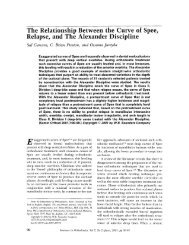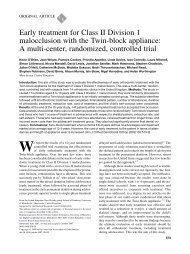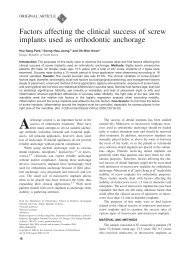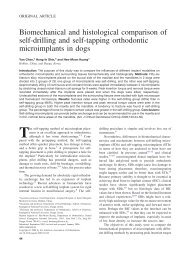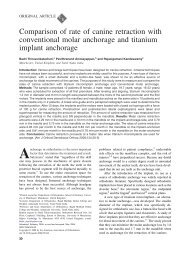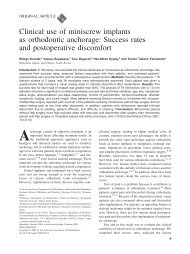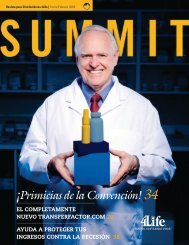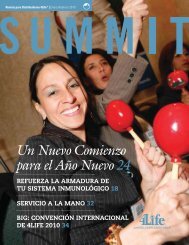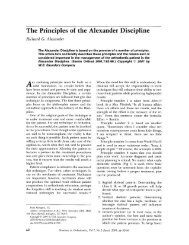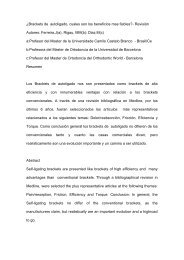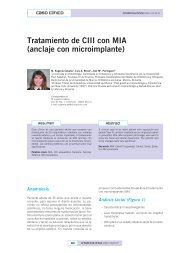Leveling the curve of Spee with a continuous archwire technique: A ...
Leveling the curve of Spee with a continuous archwire technique: A ...
Leveling the curve of Spee with a continuous archwire technique: A ...
Create successful ePaper yourself
Turn your PDF publications into a flip-book with our unique Google optimized e-Paper software.
364 Bernstein, Preston, and Lampasso<br />
Table I. Sample (n 31; 9 male, 22 female) and time<br />
characteristics<br />
Characteristic Time<br />
Mean age at T1 12 y6mo<br />
Mean age at T2 14 y 11 mo<br />
Mean age at T3 26 y4mo<br />
Mean treatment time (T2-T1) 2y5mo<br />
Mean fixed retention time 3y4mo<br />
Mean postretention time (T3-T2) 11 y5mo<br />
type <strong>of</strong> occlusal relapse after orthodontic treatment.<br />
3,12,17,21-30 In general, <strong>the</strong>se studies noted - in<br />
creases in overjet, overbite, and mandibular incisor<br />
crowding along <strong>with</strong> decreases in arch length and arch<br />
width. Although postorthodontic relapse was studied in<br />
some detail, relatively little is known about <strong>the</strong> longterm<br />
stability <strong>of</strong> leveling <strong>the</strong> COS and how <strong>the</strong> different<br />
methods <strong>of</strong> arch leveling relate to its subsequent relapse.<br />
The primary purpose <strong>of</strong> this investigation was to<br />
determine radiographically <strong>the</strong> long-term effectiveness<br />
<strong>of</strong> <strong>the</strong> Alexander discipline (<strong>continuous</strong> <strong>archwire</strong> <strong>technique</strong>)<br />
in leveling <strong>the</strong> COS in Class II Division 1<br />
deep-bite nonextraction patients. We also report on<br />
some relevant cephalometric changes that take place<br />
during arch leveling <strong>with</strong> <strong>the</strong> <strong>continuous</strong> <strong>archwire</strong><br />
<strong>technique</strong>. The cephalometric data obtained were used<br />
to determine whe<strong>the</strong>r a COS that was leveled remains<br />
stable in <strong>the</strong> long term.<br />
MATERIAL AND METHODS<br />
The sample for this retrospective study consisted <strong>of</strong><br />
<strong>the</strong> randomly selected orthodontic records <strong>of</strong> 31 white<br />
patients treated <strong>with</strong>out extractions in <strong>the</strong> private practice<br />
<strong>of</strong> Dr R.G. “Wick” Alexander in Arlington, Texas<br />
(Table I). These patients all met <strong>the</strong> following criteria<br />
for selection: <strong>the</strong>y had Class II (ANB angle 4°)<br />
skeletal patterns, at least half-step Class II molar dental<br />
relationships, incisor overbites <strong>of</strong> 50% or greater as<br />
measured on <strong>the</strong> initial (T1) study models, and angles<br />
between <strong>the</strong> mandibular plane (MP) (Go-Gn) and <strong>the</strong><br />
sella-nasion (S-N) line less than 32°. A COS equal to or<br />
deeper than 2 mm was present on all T1 models.<br />
Only patients <strong>with</strong> complete clinical records were<br />
included in this study. These records consisted <strong>of</strong><br />
radiographs and dental casts taken at T1, posttreatment<br />
(T2), and postretention (T3). All patients were retained<br />
<strong>with</strong> lower fixed canine-to-canine lingual retainers for a<br />
mean period <strong>of</strong> 3 years 4 months. The patients were all<br />
treated <strong>with</strong> fully preadjusted fixed orthodontic appliances<br />
according to <strong>the</strong> <strong>continuous</strong> <strong>archwire</strong> <strong>technique</strong>.<br />
We selected this <strong>technique</strong> for this study because <strong>of</strong> its<br />
American Journal <strong>of</strong> Orthodontics and Dent<strong>of</strong>acial Orthopedics<br />
March 2007<br />
Fig 1. Cephalometric landmarks and lines.<br />
biomechanical principles that aim to provide a level<br />
occlusal plane (OP) during and at <strong>the</strong> end <strong>of</strong> active<br />
treatment. 31<br />
Three radiographs (T1, T2, T3) were collected for<br />
each subject. The 93 radiographs were assigned random<br />
numbers to enable 1 investigator (R.L.B.) to measure<br />
each in a random, blind fashion.<br />
All radiographs were taken on a Quint Sectograph<br />
machine (Los Angeles, Calif) and were hand traced by<br />
1 operator (R.L.B.) from <strong>the</strong> original radiographs.<br />
Standard cephalometric landmarks (S, N, ANS, PNS,<br />
A, B, Go, Gn) were used to construct <strong>the</strong> reference lines<br />
required to obtain <strong>the</strong> crani<strong>of</strong>acial measurements re-<br />
32<br />
corded in this study (Fig 1). The functional OP was<br />
defined by a line intersecting <strong>the</strong> intercuspation <strong>of</strong> <strong>the</strong><br />
posterior occlusion (Fig 2).<br />
33 The following additional<br />
reference points and planes were used to measure <strong>the</strong><br />
COS; <strong>the</strong>se form <strong>the</strong> focus <strong>of</strong> this study (Figs 1 and 2):<br />
I1, <strong>the</strong> incisal tip <strong>of</strong> <strong>the</strong> most extruded mandibular<br />
incisor; L6, <strong>the</strong> highest cusp tip <strong>of</strong> <strong>the</strong> mandibular<br />
permanent first molar; L1-MP, tip <strong>of</strong> <strong>the</strong> L1 perpendicular<br />
to Go-Gn; L6-MP, mesial cusp tip <strong>of</strong> <strong>the</strong> L6<br />
perpendicular to Go-Gn; L4-MP, <strong>the</strong> cusp tip <strong>of</strong> <strong>the</strong> L4<br />
perpendicular to Go-Gn; COS line, <strong>the</strong> line joining <strong>the</strong>




